We often focus intensely on our workouts, pushing our bodies to the limit to achieve our goals. However, what we do after our workouts—our recovery and regeneration practices—are just as important as the workouts themselves. Recovery is the process by which our bodies repair and rebuild muscles, replenish energy stores, and adapt to the stress of exercise. One effective method of recovery is the use of foam rolling and stretching, which can help alleviate muscle tension, reduce soreness, and improve flexibility.
Foam rolling, also known as self-myofascial release, is a form of self-massage that involves using a foam roller to apply pressure to specific areas of the body. The goal of foam rolling is to release tension and adhesions in the fascia—the connective tissue that surrounds and supports our muscles. By rolling over tight or sore muscles, we can help increase blood flow to the area, improve tissue hydration, and reduce inflammation, leading to faster recovery and enhanced performance.
Foam rolling can be particularly beneficial for relieving muscle soreness and tightness after a tough workout. By targeting areas of tension and trigger points in the muscles, foam rolling can help alleviate discomfort and promote relaxation, allowing us to recover more quickly and effectively. Additionally, foam rolling can help improve range of motion and flexibility, which can enhance athletic performance and reduce the risk of injury.

In addition to foam rolling, stretching is another important component of post-workout recovery. Stretching helps lengthen and relax muscles, improve flexibility, and reduce the risk of injury. By incorporating stretching into our recovery routine, we can help prevent muscle imbalances, improve posture, and promote overall musculoskeletal health.
There are many different types of stretches that target different muscle groups and areas of the body. Some common stretches include static stretches, dynamic stretches, and proprioceptive neuromuscular facilitation (PNF) stretches. Static stretches involve holding a stretch position for a period of time, while dynamic stretches involve moving through a range of motion in a controlled manner. PNF stretches involve contracting and relaxing the muscles while stretching to increase flexibility.
When incorporating foam rolling and stretching into your recovery routine, it’s important to listen to your body and pay attention to how it responds. Start slowly and gradually increase the intensity and duration of your foam rolling and stretching sessions as your body adapts. Focus on areas of tightness or soreness, and be sure to breathe deeply and relax into each stretch to maximize its effectiveness.
Foam rolling and stretching are valuable tools for promoting muscle relief and enhancing recovery after exercise. By incorporating these practices into your post-workout routine, you can help alleviate muscle tension, reduce soreness, and improve flexibility, allowing you to recover more quickly and effectively and perform at your best. Remember to listen to your body, take it slow, and be consistent in your foam rolling and stretching efforts to reap the full benefits of these recovery techniques.





